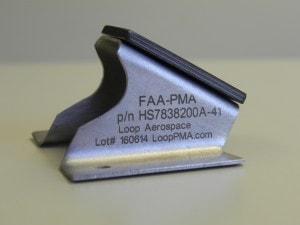
The aerospace industry is concerned with the manufacture and maintenance of vehicles that operate within or above Earth’s atmosphere. It encompasses airlines, satellites, and spacecraft, including all of the equipment and components included therein. Due to the highly precise nature of aerospace vehicles, parts for aerospace equipment must be serialized and traceable. Ideally, identifying markings are engraved in the component’s surface rather than printed or painted, so as to prevent the marks from wearing away.
Since aerospace components are regularly subject to harsh conditions and extreme temperatures, it is important that the engraved information be durable and long-lasting. For these reasons, laser marking is the ideal solution for marking a wide range of aerospace parts and components.
Laser marking is perfect for use in aerospace components, as it provides the benefit of clear, precise, and highly durable markings. Regardless of the conditions, laser markings have proven to be especially reliable since they won’t fade away for a long time when deeply etched. What’s more, the laser marking process is efficient, extremely fast, and environmentally friendly.
Industrial laser marking can be used to engrave serial numbers, barcodes, and a wide range of identifying information, even on very hard or coated materials. Unlike other processes, laser marking is not limited by the size or shape of the component, and can be used to engrave very small, curved, or unusually shaped parts with ease.
Laser marking equipment etches parts much more quickly and efficiently than other processes. The equipment typically marks components as fast as several characters per second and does not require the use of additional products such as ink or corrosive chemicals, thereby saving both time and money in the marking process.
Laser markings are highly precise and easily repeated. Engraved laser markings will not spread or blur, so markings always remain clear and precise within their final applications. The information is computerized, which ensures accuracy and reduces the potential for error. Unlike other marking processes, there is no risk of damage to the parts. This sets laser marking apart from chemical etching, which uses potentially damaging chemicals to mark the surface.
 Durability
DurabilityChemical etching, inkjet printing, and hand engraving can’t match the durability of laser markings. Laser marked components will retain their identifying information even when exposed to extreme temperatures, harsh environments, and corrosive chemicals. The marks will not wear off or fade.
Since laser marking uses a laser to etch the surface of the component’s material, it does not create waste products or materials that are harmful to the environment. There is no waste produced in the process—unlike inkjet and chemical etching processes, and their maintained containers of inventory or packaging for marking materials.
Due to the highly sensitive and potentially dangerous nature of aerospace equipment, a wide range of federal laws and regulations apply to parts used in the aerospace industry. Laser marking ensures that parts and components manufactured for aerospace equipment are easily identified and tracked, facilitating compliance with even the most rigorous requirements.
In addition to making components easily identifiable, laser markings can be made to connect with the Industrial Internet of Things (IIoT) to generate enhanced tracking and functionality. Laser engraved serial numbers and barcodes make it easier for items to be identified and processed in computerized systems.
Industrial laser marking systems can be used for a particularly broad array of materials. Aerospace materials that commonly benefit from laser marking include:

Laser marking is the best way to produce certification symbols, barcodes, serial numbers, company logos, and other customized markings for a wide variety of components, assemblies, and machinery in a range of applications, including:
Industrial laser marking offers unlimited possibilities in terms of marking, including complicated symbols, text, logos, and graphics. The method guarantees clear, legible permanent marks on virtually any aerospace part.
At Hai Tech Lasers, we are pleased to provide the highest-quality laser marking solutions in the industry. As new aerospace products develop, it is more important than ever to mark them with effective identifying markings and computer-readable codes. For more information on our superior laser marking services, contact us today or request a quote by clicking below.
